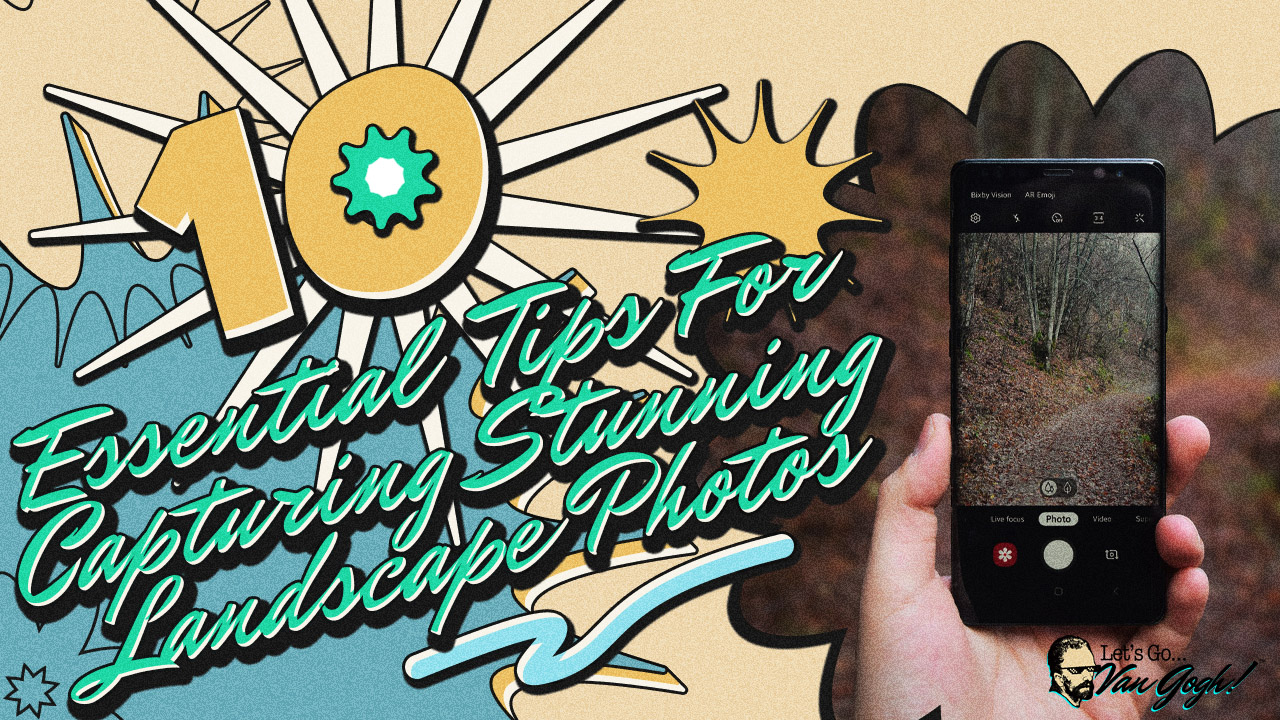Introduction:
Landscape photography is a captivating art form that allows us to capture the beauty of nature and showcase it to the world. However, capturing stunning landscape photos requires more than just pointing and shooting. It demands preparation, patience, and a solid understanding of technique. In this blog post, we will delve into the essential tips that will help you elevate your landscape photography skills and capture breathtaking images that truly stand out.
1. Understanding the Golden Hours
The golden hours, which occur during sunrise and sunset, offer photographers a magical window of soft, warm lighting that can transform ordinary landscapes into extraordinary scenes. To make the most of these hours, it is crucial to plan ahead. Scout locations in advance to determine where the sun will rise or set, and be prepared to arrive early. This will give you ample time to set up your equipment and find the perfect composition before the golden light bathes the landscape in its warm glow.
During these hours, the angle of the sun creates long shadows and adds depth to your images. Experiment with different angles and perspectives to make the most of this beautiful lighting. Additionally, consider using a tripod to ensure stability and sharpness in your photos, as the lower light conditions may require longer exposure times.
2. Mastering Composition
Composition is one of the key elements in landscape photography that can make or break an image. The rule of thirds is a fundamental principle that helps create visually pleasing compositions. Imagine your frame divided into a grid of nine equal parts by two horizontal lines and two vertical lines. Place your main subject or focal point along one of these lines or at an intersection point for a more balanced and aesthetically pleasing composition.
Leading lines are another powerful compositional tool in landscape photography. These lines can be natural or man-made elements that guide the viewer’s eye through the image, creating depth and visual interest. Look for roads, rivers, fences, or even paths created by patterns in nature to incorporate leading lines into your compositions.
Foreground interest is another technique to add depth and dimension to your landscape photos. By including a prominent element in the foreground, such as rocks, flowers, or a tree branch, you create a sense of scale and draw the viewer’s attention into the scene. Experiment with different focal lengths and perspectives to find the perfect balance between foreground interest and the background.
3. Maximizing Depth of Field
Achieving sharpness throughout your entire landscape scene is essential for capturing stunning photos. Depth of field refers to the range of distance in your image that appears acceptably sharp. To maximize depth of field, you need to understand how aperture settings affect it.
A smaller aperture (higher f-number) such as f/16 or f/22 will increase the depth of field, resulting in more elements in your scene being in focus. However, keep in mind that using very small apertures can lead to diffraction and reduce overall image sharpness. It’s best to experiment with different apertures to find the sweet spot for your lens where you achieve a balance between sharpness and depth of field.
Additionally, focusing techniques play a crucial role in achieving sharpness throughout your landscape scene. Consider using hyperfocal distance focusing, which ensures that everything from a certain distance to infinity is within an acceptable focus range. This technique maximizes depth of field and allows you to capture sharp details throughout your image.
4. Using Filters Effectively
Filters are indispensable tools in landscape photography that can have a significant impact on your final images. There are several types of filters commonly used: polarizing filters, neutral density (ND) filters, and graduated ND filters.
A polarizing filter helps reduce reflections and glare from non-metallic surfaces such as water or foliage, resulting in more saturated colors and increased contrast. It also enhances the appearance of skies by darkening them and making clouds more prominent.
ND filters are essential for controlling exposure in bright conditions when you want to use longer shutter speeds or wider apertures. They come in different strengths (measured in stops), allowing you to reduce the amount of light entering your lens without affecting color balance.
Graduated ND filters are useful for balancing exposures between different parts of the scene with varying brightness levels. They have a gradient from dark to clear that can be positioned over the part of the image that needs exposure correction, such as a bright sky.
Understanding how and when to use these filters effectively can greatly enhance your landscape photography. Experiment with different combinations and learn how they can help you achieve your desired results.
5. Scouting and Exploring Locations
Finding unique perspectives and captivating landscapes often requires scouting and exploring locations beforehand. Take the time to research potential locations using online resources, maps, or even social media platforms where photographers share their favorite spots.
Once you have identified a location, visit it during different times of the day and year to observe how lighting conditions change. This will allow you to plan ahead and determine when the best time is to capture the scene under optimal lighting conditions.
Utilize smartphone apps specifically designed for landscape photographers that provide information about sunrise and sunset times, moon phases, and even augmented reality features that show you where the sun will rise or set at a given time from your current location.
By thoroughly scouting and exploring locations, you can discover hidden gems and capture unique perspectives that set your landscape photos apart from others.
6. Paying Attention to Weather Conditions
Weather conditions play a crucial role in landscape photography as they can dramatically impact the mood and atmosphere of your images. Different weather conditions offer unique opportunities for capturing stunning landscapes.
Clear blue skies are perfect for capturing vibrant colors and expansive views, while partially cloudy skies add drama with dynamic cloud formations. Stormy weather can create moody atmospheres and dramatic lighting conditions that add an extra layer of interest to your photographs.
However, it is important to prioritize safety when photographing in adverse weather conditions. Be aware of any potential hazards such as lightning storms or strong winds that could pose risks to both you and your equipment. Always take precautions and protect your gear with rain covers or waterproof bags if necessary.
7. Capturing Movement
Capturing movement in landscapes can add a sense of dynamism and energy to your photos. One way to achieve this is by adjusting your shutter speed. Slower shutter speeds (e.g., 1/4th or slower) are ideal for capturing smooth flowing water or creating dreamy effects with moving clouds.
On the other hand, faster shutter speeds (e.g., 1/500th or faster) freeze motion and are perfect for capturing waves crashing against rocks or freezing droplets in mid-air.
Experiment with different shutter speeds to achieve the desired effect while ensuring that other aspects like exposure and focus are properly managed.
8. Embracing the Blue Hour
The blue hour refers to the period just before sunrise or after sunset when the sky takes on a beautiful blue hue. This time of day offers a unique opportunity to capture serene and moody landscapes with soft lighting.
To make the most of this time, adjust your exposure settings accordingly. As the light diminishes during this hour, be prepared to use longer exposures or higher ISO settings while maintaining proper exposure levels.
White balance adjustments are also crucial during the blue hour as they can greatly influence the overall mood of your images. Experiment with different white balance settings such as daylight or tungsten to achieve different tones and atmospheres in your photographs.
9. The Importance of Patience
Patience is a virtue that every landscape photographer must embrace. Waiting for the perfect light or moment can sometimes take hours or even days. It is during these moments of waiting that some of the most stunning landscape photos are captured.
Use this time wisely by taking test shots, experimenting with different compositions or focal lengths, or observing how the lighting conditions change as time passes by. Patience also allows you to fully immerse yourself in nature, appreciating its beauty beyond just capturing it through your lens.
Remember that landscape photography is not just about capturing images but also about enjoying the process and being present in the moment.
10. Post-Processing Techniques
Post-processing is an integral part of modern-day landscape photography. While it is important to capture a well-exposed and well-composed image in-camera, post-processing allows you to enhance colors, contrast, and details further.
There are various post-processing software available such as Adobe Lightroom, Capture One, or Luminar that offer powerful editing tools specifically designed for landscape photography. These tools allow you to adjust exposure levels, fine-tune colors, enhance details through sharpening or noise reduction techniques, and even blend multiple exposures for HDR (High Dynamic Range) images.
Additionally, there are numerous online tutorials and courses available that can help you develop your post-processing skills further.
Remember that post-processing should be used as a tool to complement your vision rather than an avenue for drastic alterations or unrealistic enhancements.
Conclusion:
Capturing stunning landscape photos requires more than just technical knowledge; it demands an artistic eye, patience, perseverance, and an appreciation for nature’s beauty. By understanding the significance of shooting during golden hours, mastering composition techniques, maximizing depth of field, using filters effectively, scouting locations in advance, paying attention to weather conditions, capturing movement, embracing the blue hour, practicing patience, and utilizing post-processing techniques responsibly, you can elevate your landscape photography skills and create breathtaking images that truly stand out.
So pack your camera gear, venture into nature’s wonders, and let these essential tips guide you on your journey towards capturing stunning landscape photos!
Call-to-action:
We would love to see your stunning landscape photos or hear about any additional tips you might have! Share them with us in the comments below! Don’t forget to follow/subscribe for more photography tips and tutorials!






 No products in the cart.
No products in the cart.